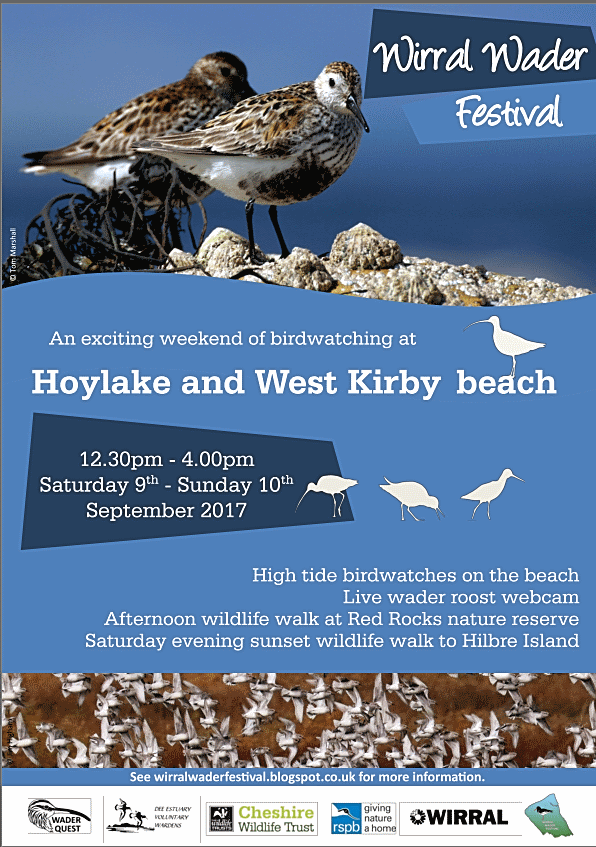Site menu:

August 2017 Newsletter
WeBS Reports 2015/16.
Colour Ring Report.
NEW publication - Rare and Scarce Birds of Cheshire and Wirral.
July Bird News.
Forthcoming Events.
Latest Newsletter.
Wetland Bird Survey Reports 2015/16.

http://www.fromthemuddybanksofthedee.com/
Both the local and national Wetland Bird Survey Reports for 2015/16 have been published and here I give a brief summary. It is always fascinating to see how our wetland birds are doing and whether trends are due to local factors or reflect what is happening on a national scale.
Although the autumn of 2015/16 was nice and settled it has to be said that the winter was a bit of a miserable one with rain and winds. Weather certainly has an effect on bird numbers and generally wader counts on the Dee Estuary were low but wildfowl didn't do too badly - perhaps it was a case of 'nice weather for ducks'.
I've picked out six species to go into more detail:Great Crested Grebe

There continues to be a large flock of this species off North Wirral, present throughout the year apart from the breeding season. Highest counts for 2015/16 were 961 on October 10th and 749 on February 25th. Conditions have to be very settled, and the sea flat calm, in order to obtain a good count; for that reason counts are not usually carried out during the official monthly Core Count day and are therefore submitted for WeBS as supplementary counts. The five year average of 849 means that the North Wirral foreshore is the second most important site in the country for this species, although nowhere near the massive numbers at Dungeness and Rye Bay where they had 2,420 in January 2016.
Shelduck
Shelduck are undergoing a slow but steady decline both nationally and locally after peaking in the UK in the 1990s, and on the Dee Estuary in 2004/05 with 13,334. After a very low peak of only 5,061 in 2013/14 numbers have increased since with 6,947 in 2014/15 and 7,171 in 2015/16. The five year average of 6,720 makes the Dee the second most important site in the country with the adjacent Mersey Estuary the most important where there was a count of 10,667 in 2015/16. The Mersey is a post breeding moulting site (numbers peak in August) and undoubtedly many then make there way to the Dee Estuary where peak count is usually in September or October.
Teal
Peak count of Teal was 6,839 on September 13th, and this was the third ever highest WeBS count for this species on the Dee Estuary; the highest being 10,715 in December 1991 followed by 9,825 in December 1989. The Dee Estuary 2015/16 max was the third highest in the country for that year although the most important site, Somerset Levels, did have rather more with 30,313! The birds were obviously moving around a lot that year as, although the WeBS count for Nov 15th was only 3,391 for the whole estuary, there was a very high count of 8,000 at Burton Mere Wetlands just a few days earlier on Nov 8th. In the country as a whole Teal are doing well with counts having plateaued out at the turn of the century at a high level after a steady increase for the previous 30 years or so.
Oystercatcher

There was a very worrying drop in Oystercatcher numbers on the Dee Estuary in 2015/16, you could almost call it bizarre. You can see from the above graph that once birds return from breeding in August numbers don't vary a great deal right through to January after which birds then disperse again to breed. The previous two years were very typical with counts pretty close to the average for the previous 35 years. Oystercatchers are very site faithful so you wouldn't expect very much in the way of month to month variation or even year to year variation. But 2015/16 counts were not only less than half the previous two years but numbers actually decreased through the winter, instead of the more normal small increase.
So what went wrong? The reasons for the
drop are likely to be
complex but a major issue would seem to be lack of food
brought about by the decision to open the cockle beds during the
critical autumn arrival. The Dee Estuary Cockling Order is supposed to
guarantee enough food for the birds whilst maintaining a sustainable
cockle fishery, something seemed to go badly wrong in 2015!
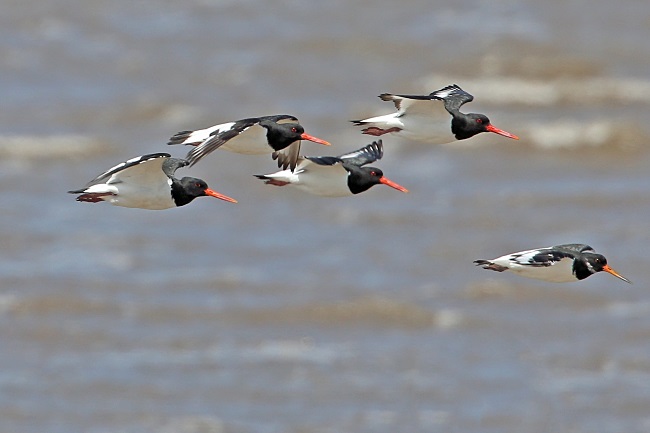
Two bits of good news, the first is
that numbers recovered
somewhat in 2016/17 with a max of 20,857 in November. This is still
well below the previous two years but nevertheless a welcome increase.
Secondly, the Dee Estuary remains the third most important site in the
country for this species behind Morecambe Bay and Solway Firth.
Dunlin
We've had a couple of relatively good years for Dunlin with the highest August count since the 1970s in 2014 (24,232) whilst the peak winter count has increased for the third year in a row and was 18,419 on Dec 13th 2015. Nationally, numbers have stabilised after a decline since the early 1990s put down to birds 'short-stopping' when they tend to stay in continental Europe due to mild winters. But the big story in 2015/16 was a record breaking count on the nearby Mersey Estuary with 68,334 in December. This was the highest ever count for the Mersey and only ever bettered nationally at the far larger Morecambe Bay when there were two years in the 1990s when counts reached over 70,000. There must have been a big movement westwards in December 2015. The Severn Estuary had 34,489 on the same day as the high Mersey count, which was their highest count for many years, as well as the Dee Estuary's peak winter count of 18,419.
Black-tailed Godwit
The Icelandic sub-species of
Black-tailed Godwit (islandica)
breed in
Iceland and winter mainly in the UK, Ireland, France and
Iberia; they
have increased rapidly since the early 1980s although numbers
have
plateaued out in the past three to four years. The rise in numbers on
the Dee estuary has been particularly spectacular having increased from
three to four hundred in 1985 to 6,159 counted on October 18th 2015,
consequently the Dee is currently the third most important site in the
country for
this species, both in 2015/16 and over the five year average.
Although the October count in 2015 was high, over the following winter counts were actually quite low. It was very noticeable on Thurstaston Shore, where numbers are usually around the 2,000 level in November and December, that as soon as the gales and heavy rain arrived in early November the godwits just disappeared. However, they don't seem to have flown very far and there was a massive count of 6,680 at Marshside RSPB Reserve on the Ribble Estuary in December and counts were high on the Mersey Estuary in the second half of the winter - we know from colour ringing that there is much interchange between these sites and the Dee Estuary so it seems very likely that's where many of 'our' birds went.
References/Sources of Information:
1. Frost T.M. et al. WeBS Report
Online: Waterbirds in the UK 2015/16. BTO, RSPB and JNCC in association
with WWT.
https://www.bto.org/volunteer-surveys/webs/publications/webs-annual-report
2. Neil Friswell and Colin E. Wells, Dee Estuary and North Wirral Foreshore: WeBS Annual Report 2015/16.
3. Lancashire Bird Report 2015.
Top of PageColour Ring Report
An interesting month, particularly with
colour-ringed terns of which more below. With so many gulls turning up
after breeding it was no surprise to see a ringed Black-headed Gull,
another one ringed in Essex but where do these breed? Given the large
number of Oystercatchers on the estuary we see surprisingly few ringed
ones, so it was nice to spot one at Hoylake. Large numbers of
Black-tailed Godwits were returning from Iceland through July reaching
over 2,000 at Caldy by the month-end - in total we saw 14 different
colour-ringed birds and I give details of three of these below.
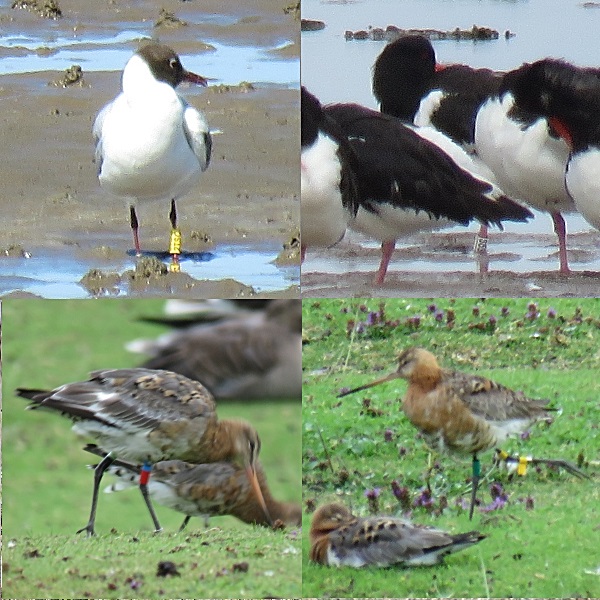
Black-headed Gull
2TSC - black on yellow ring.Ringed at Pitsea Landfill Site, Essex on March 11th 2017.
Recorded at West Kirby Shore on July 8th and 22nd.
This is the third black-headed Gull in the past three years which has been ringed by the North Thames Gull Group at Pitsea Landfill, and all in March.
Oystercatcher
S59 - Black on white ring.Ringed as a chick on the roof of Aberdeen University Library on June 22nd 2010.
Recorded at Hoylake Shore on July 22nd 2017.
Also recorded at Seaforth Nature Reserve on May 6th and July 6th 2011.
This is what Alistair Duncan of the Grampian Ringing Group said:
"We have been monitoring Aberdeen's roof-nesting/urban nesting Oystercatchers since 1986 and putting on Darvics since 1997. In winter the majority of our birds go south and west to north west England, Ireland and Wales. Smaller numbers winter in other estuaries and some stay here.
S59 is now seven years old and will winter every year in your area, as they are very site faithful. If only we knew where it is breeding!"
Black-tailed Godwits
LN-BR - ringed as a chick in northern Iceland on July 15th 2013.Recorded on Thurstaston Shore on July 5th 2017, then subsequently at Caldy on several dates in the same month.
First record after ringing was at Marshside (RSPB) in October 2013 since when it has been seen many times at Gilroy (West Kirby) during late summer and autumn in both 2015 and 2016, and on Thurstaston Shore in the winters of 2014/15 and 2016/17. It was at Slimbridge Wetlands and Wildfowl centre in July and August 2016 before moving north to Gilroy.
GG-YYflag - ringed as a chick in southern Iceland on June 23rd 2013.
Recorded at Caldy on many dates through July 2017.
This bird has been mainly recorded at Gilroy (West Kirby) in late summer and autumn, with occasional sightings on Thurstaston Shore. The only winter records came in 2016/17 when it was seen on many dates on Thurstaston Shore.
As you may be able to tell from the photograph this bird has a badly damaged leg and somehow the Yellow Flag has been pulled down from the tibia to the tarsus.
LO-OR - ringed as a chick in northern Iceland on July 14th 2004.
Recorded on Heswall Shore on July 4th 2017 and subsequently at Marshside RSPB (Southport) on July 13th.
This bird spent it's first autumn and winter in SW Ireland before turning up in the Netherlands in April 2006. April 2007 saw it on Frodsham Marsh and the following winter it was seen just once, at Marshside in January 2008. There was another record in the Netherlands in March 2008. In 2010 it must have taken a year off from breeding as it was in north Norfolk throughout that summer but it must have been breeding again in 2013 as it was spotted in Iceland. Very few records then until it turned up at Marshside again from July to November 2016, the next sighting being at Heswall in 2017.
Terns
In the Irish Sea colonies colour-ringing of terns only started over the past three to four years, they will undoubtedly transform our knowledge of these birds. With their short legs the rings are very difficult to read, especially on the estuary, but we were lucky enough to be able to use a Land Rover as a hide to get close to two juvenile Sandwich Terns in July. It is slightly easier to get close to the birds in their breeding colonies as they are used to the wardens being there, and you will see that there have been a good number of colour-ringed Little Terns seen at Gronant this summer.Sandwich Terns
The Dee Estuary is one of the most important post-breeding sites in the country for this species. The colony at Cemlyn Bay (Anglesey) is the nearest breeding colony but strangely there is no evidence that any come from there, however there is evidence from ringing returns that birds come from Ireland including the two colour-ringed juveniles below together with one from the same colony last year.
KHT
- black on yellow ring.
Ringed as a chick on Ladys Island Lake, County Wexford, Ireland, on
June 21st 2017.
Recorded close to Little Eye on July 20th 2017.
KLD
- black on yellow ring.
Ringed as a chick on Ladys Island Lake, County Wexford, Ireland, on
July 3rd 2017.
Recorded close to Little Eye on July 20th 2017.
Little Terns

© Jack Slattery and the Gronant Wardens
There were record numbers of colour-ringed Little Terns observed at Gronant in 2017 with a total of 31 birds recorded a total of 65 times. 11 were ringed at Gronant, eight from the Isle of Man, 11 from Kilcoole in Ireland and one ringed in both Kilcoole and Isle of Man, more of which below. Kilcoole is just north of Wexford, so not far from where the Sandwich Tern colony is (see above); the colony there is a bit bigger than at Gronant whilst the Isle of Man colony at Point of Ayre typically has 30 to 60 pairs. I'm told that the Irish Sea colonies all had a good breeding season, which is certainly good news.
Here are details of two Colour-ringed Little Terns of particular interest:
AAD - black on yellow ring.
Recorded at Gronant on June 9th 2017.
Ringed as a chick at Kilcoole, Ireland, on June 25th 2004 when it was given a metal ring. It was then caught at Rue Point, Isle of Man, 10 years later (May 2014) and given a colour ring. This bird is now 13 years old.
XCJ - black on yellow ring.
Recorded at East Chevington, Northumberland, on July 3rd 2017.
Ringed as a chick at Gronant on July 10th 2016.
Notable for two reasons, that it came back to the UK in it's first summer, perhaps more common than previously thought, and the first Gronant colour-ringed bird to be seen away from the Irish Sea.
Richard
Smith.
Colour-rings were also reported by Matt Thomas, Steve
Hinde, Alan Hitchmough, Jack Slatterly, Henry Cook and the Gronant
Wardens.
New Publication
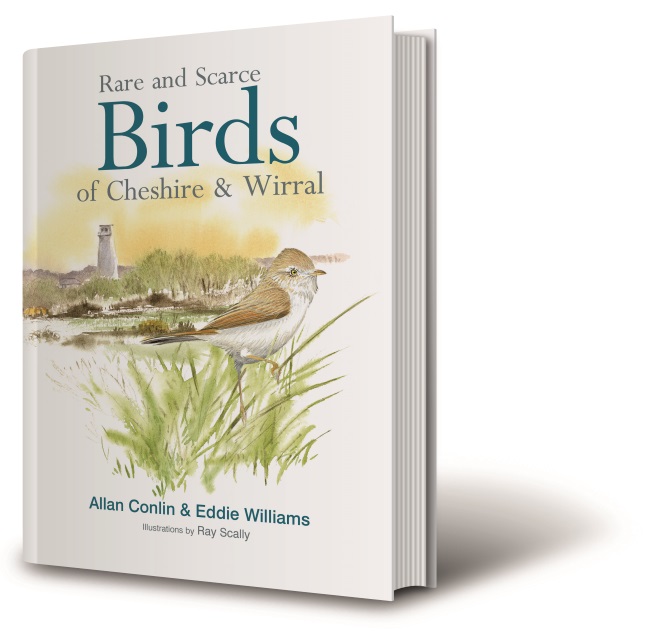
This eagerly awaited book is soon to be published and there will be a full review in this newsletter within the next month or two. The cost will be £24.99 + PP. For further details and to order please email rarebirdingwirral@gmail.com.
Top of Page
July Bird News
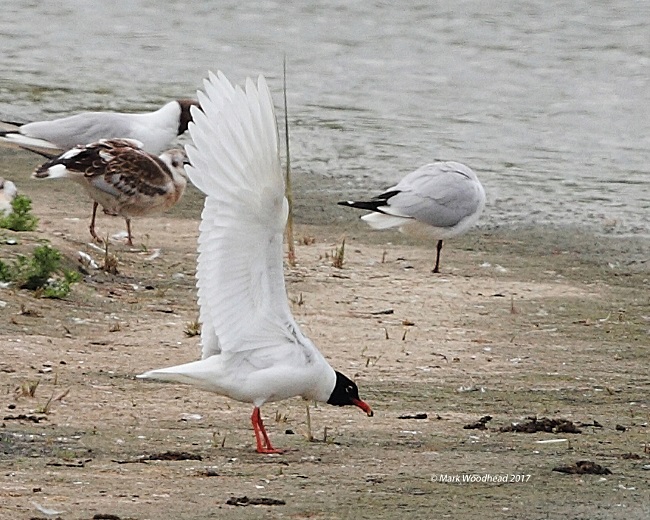
The month started with the news of two Mediterranean Gull chicks hatched at Burton Mere Wetlands, the first for that site and the first successful breeding of this species in Cheshire outside of Delamere Forest. Elsewhere, Mediterranean Gulls were seen right across North Wirral shore, West Kirby, Heswall and Gronant with highest count of four at West Kirby on the 8th.
There were the usual Sandwich Terns using the estuary as a staging post including 700 at Hilbre on the 18th and 559 at Hoylake on the 23rd, plenty of juveniles were observed. It has been a bit of a strange season at the Gronant Little Tern colony with breeding starting very early in May, these produced over 100 fledglings by early June but because a lot of nests were lost many re-layed - as a result the season was now unusually late as the chicks from these late nests were becoming fledglings through the second half of July. The total number of fledglings will probably end up around 200, more than last year's 171 and the second highest ever produced at Gronant.
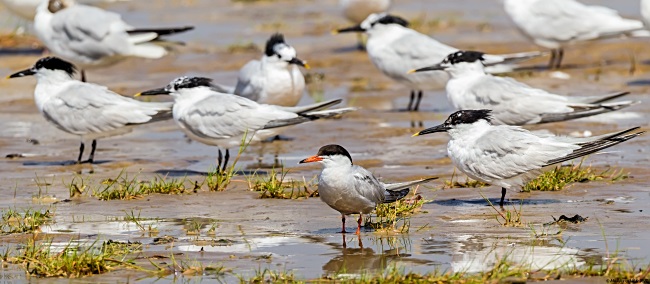
Waders returned in good numbers and there was a good passage of
Whimbrels around the third week of the month with 36 at Gronant on the
19th, and 42 at Heswall and 21 at Hilbre both on the 21st. Black-tailed
Godwits had reached over 2,000 at Caldy by the month end, a very good
count for July, they roosted at high tide in a private Wildfowl
collection and fed on the estuary between Thurstaston and West Kirby at
low tide. The first juveniles were arriving by the month-end, the
earliest we've ever seen them. Other notable counts of waders included
six Common Sandpipers at Heswall on the 4th and 212 Sanderling at
Gronant on the 19th.
Two or three Great White Egrets were recorded all month at Burton and across to Shotton and Connah's Quay, peaking at the Connah's Quay Reserve with four on the 31st. Another notable record at Connah's Quay was of three Red Kites flying behind the reserve on the 25th.
There was a report of a 'probable' Lesser Yellowlegs below the Dee Bridge by Connah's Quay on the 14th (but news was only released three days later), with a claimed 'confirmed' sighting on the 21st on Outer Burton Marsh. I don't know the full circumstances of the first record but was contacted directly by somebody on the 21st who said a 'Verifier' who wished to remain anonymous had confirmed the ID, but no details of the exact location or circumstances were forthcoming. I regard the record on the 21st suspicious, indeed highly improbable, which in turn must put the initial record in doubt.
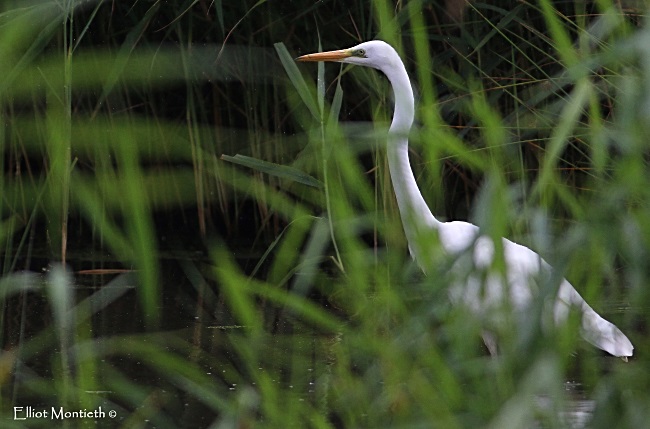
https://elliotsbirdingdiaries.wordpress.com/
Many thanks go to David Haigh, Mal Sergeant, Ellliot Montieth, Steve Hinde, Jeremy Bradshaw, Mark Turner, Mark Gibson, Matt Thomas, Mark Woodhead, Chris Butterworth, Roy Lowry, Paul Shenton, David Leeming, Jeff Cohen, Alan Hitchmough, Richard Whitby, Les Hall, Chris smith, Steve Williams, Richard Speechley, Dave Edwards, Paul Mason, Richard Beckett, Peter Haslem, Karen Leeming, Geoff Robinson, Linda Platt, Ian Douglas, Colin Schofield, Gavin Butler, Allan Conlin, George Knight, Ian Fleming, Hugh Stewart, Frank Burns, Alec Thomasson, Jack Slatterly, Henry Cook, Steve Dewsnap, Charles Farnell, Pete and Marjo Lewis, Brian Tollitt, David Thompson, Neil Mcmorran, the Lighthouse and Wirral Birding Blog, the Dee Estuary Wardens and the Hilbre Bird Observatory for their sightings during July. All sightings are gratefully received.
Top of Page
What to expect in August

http://www.fromthemuddybanksofthedee.com/
Given a fresh westerly wind expect good numbers of Gannets and Manx Shearwaters out to sea, and lots of terns at their high tide roosts, which could include a few Black Terns. A north-west gale at the end of the month could well blow in a few Leach's Petrels as well as a selection of skuas.
Top of Page
Forthcoming Events
August Highest Spring Tides (Liverpool)
Also
see Tides
page.
22nd August, 12.21hrs (BST), 9.5m.
23rd August, 13.03hrs (BST), 9.6m.
24th August, 13.42hrs (BST), 9.5m.
Forthcoming Events
Organised by the Wirral
Ranger Service , Flintshire
Countryside Service and the
RSPB (Dee Estuary):
All these events and walks have bird interest, even those not
advertised specifically for birdwatching. No need to book for these
events unless specified - please check below.
1 pm start.
Price: Free (normal reserve entry charges apply to non-members).
Join
one of our friendly, knowledgeable volunteers for a leisurely amble
around much of Burton Mere Wetlands, including the unmissable viewpoint
at the end of the Hillfort Trail on Burton Point. Take in the sights
and sounds, learn more about the wildlife that thrives here, the work
we do to give nature a home and the remarkable history of the estuary.
Great
for first time visitors or those looking to brush up on their
identification skills; with constant changes as we move through the
seasons, it's impossible to predict what might be seen. Summer may be a
quieter time for birds since they finish defending territories as
breeding season ends, but the growing avocet chicks and fledged little
egrets and herons loafing close to the hides are great to watch. Warm
sunny days will bring out the various dragon and damselflies that make
their home on the reserve, along with butterflies and basking common
lizards! Some birds begin their return migration just as we are getting
settled into summer so sometimes unexpected birds may be found.
No
booking required, just turn up on the day. A reasonable level of
fitness and sturdy footwear are required. Walks typically last up to 3
hours, weather permitting.
Ring 0151 353 8478 for further details.
WIRRAL WADER FESTIVAL September 8th to 10th 2017 - Further details will be published in September Newsletter on this website but here are a few highlights:
Friday September
8th: Iolo Williams Friday Evening Talk - Wildlife of the
Welsh Coast.
Where: Heswall Hall, Heswall
Time: Doors open 7.00pm for 7.30pm start. Cost £15. Booking
essential.
Parking: CH60 0AF (for sat nav use CH60 4RH). Nearby municipal car
parks free after 6.30pm
Booking: www.cheshirewildlifetrust.org.uk/whats-on
Saturday
September 9th: Sunset walk to Hilbre Island.
Saturday 5.30pm-8pm. Booking
essential. £3 fee
Jo in Wirral Rangers and Cheshire Wildlife Trust o n a magical w alk to
Hilbre
Island. Contact wcp@wirral.gov.uk to book and for
meet ing details.
(Composting toilet available on the Island, no other facilities).
